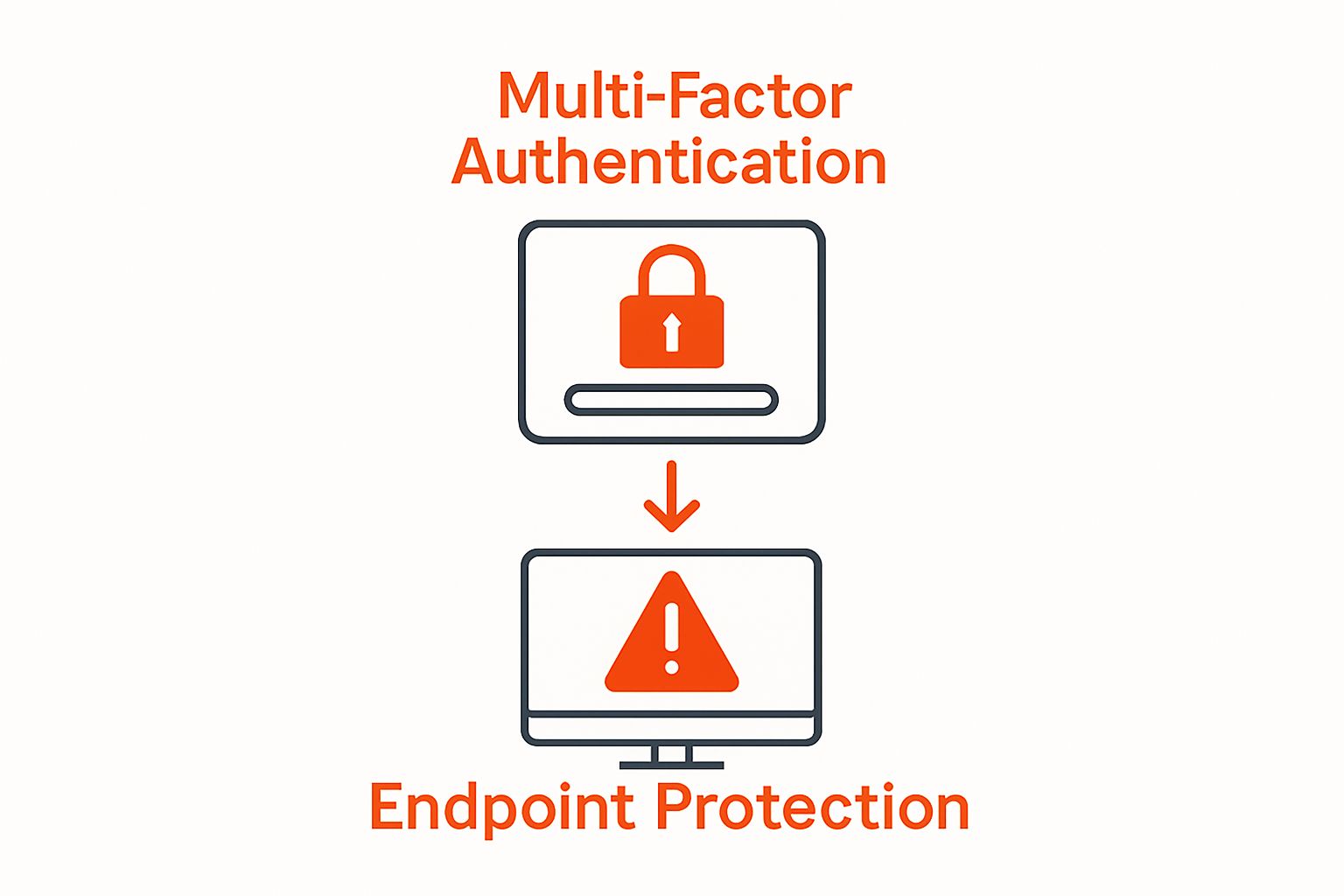
How to Improve Cybersecurity for Your Business Today
Cyber attacks are becoming smarter every year and South African companies are in the crosshairs. Think your small business is flying under the radar. Not quite. A single overlooked device or weak password can open the door for cybercriminals, putting your entire operation at risk. Most breaches do not start with fancy hacking tools, but with simple mistakes nobody spotted. This guide shows how turning small habits into serious cyber habits can save your business from a massive headache.
Table of Contents
- Step 1: Assess Your Current Cybersecurity Posture
- Step 2: Identify and Prioritize Cyber Risks
- Step 3: Develop a Comprehensive Cybersecurity Strategy
- Step 4: Implement Essential Security Measures
- Step 5: Conduct Regular Testing and Updates
- Step 6: Educate Staff on Cybersecurity Best Practices
Quick Summary
| Key Point | Explanation |
|---|---|
| 1. Conduct a comprehensive cybersecurity assessment | Inventory all digital assets and evaluate current security protocols to identify vulnerabilities. |
| 2. Prioritize cyber risks effectively | Use a risk scoring mechanism to focus on high-impact vulnerabilities and allocate resources efficiently. |
| 3. Develop a cohesive cybersecurity strategy | Translate risk findings into clear, actionable security policies that cover all technical and human aspects. |
| 4. Implement strong security measures | Employ multi-factor authentication, encryption, and advanced endpoint protection to create robust barriers. |
| 5. Educate staff on best practices regularly | Ongoing training transforms employees into active defenders, reducing human error in cybersecurity. |
Step 1: Assess Your Current Cybersecurity Posture
Understanding your current cybersecurity landscape is like performing a comprehensive health check for your business’s digital infrastructure. Before you can strengthen your defences, you need a clear picture of existing vulnerabilities and potential risks. A thorough cybersecurity assessment reveals hidden weak points that cybercriminals might exploit.
Begin by conducting an exhaustive inventory of all digital assets within your organization. This means mapping every network device, computer, server, mobile device, and cloud service connected to your systems. Each endpoint represents a potential entry point for cyber threats, so comprehensive documentation is critical. Pay special attention to devices that might be overlooked, such as network printers, IoT devices, and remote work equipment.
Next, evaluate your current security protocols and tools. Review firewall configurations, antivirus software versions, access control mechanisms, and existing security policies. Look for inconsistencies or outdated practices that could compromise your network. Creating a detailed security baseline helps identify immediate improvement areas. Our comprehensive IT security audit checklist can guide you through this intricate process, providing a structured approach to understanding your current cybersecurity state.
Critical verification points for this assessment include:
- Documenting all network-connected devices
- Identifying software and hardware versions
- Mapping user access permissions
- Reviewing recent security incident logs
The goal is not just to create an inventory but to understand the intricate relationships between your digital systems.
Below is a checklist table to help you verify all critical components during your cybersecurity assessment, ensuring nothing is overlooked in establishing your security baseline.
| Verification Point | What to Check | Key Outcome |
|---|---|---|
| Network-connected devices | List every computer, printer, IoT, and mobile | Complete device inventory |
| Software and hardware versions | Document all installed software and firmware levels | Spot outdated or vulnerable assets |
| User access permissions | Map who has access to what systems and data | Identify excessive privileges |
| Security incident logs | Review recent logs for anomalies or breaches | Detect past or ongoing threats |
| Firewall and antivirus status | Check configuration and if definitions are updated | Ensure protection is current |
Remember that cybersecurity assessment is not a one-time event but an ongoing process. Technology evolves rapidly, and so do cyber threats. Regular reassessments ensure your security measures remain robust and adaptive to emerging challenges.
Step 2: Identify and Prioritize Cyber Risks
Identifying and prioritizing cyber risks transforms abstract security concerns into a strategic action plan. Not all risks are created equal, and understanding which vulnerabilities pose the most significant threats allows businesses to allocate resources efficiently and protect critical systems effectively.
Start by conducting a comprehensive risk assessment that goes beyond surface-level evaluations. Examine potential threats from multiple angles: external malicious actors, internal human error, system vulnerabilities, and potential compliance gaps. Consider the specific characteristics of your business environment, including industry regulations, technological infrastructure, and unique operational workflows. This process requires a deep understanding of how data moves through your organization and where potential weak points might exist.
Our detailed cyber risk assessment guide can provide structured methodology for systematically evaluating your digital ecosystem. The key is developing a risk scoring mechanism that considers both the potential impact and likelihood of different cybersecurity scenarios.
Prioritization demands a nuanced approach. Evaluate risks based on multiple dimensions such as potential financial damage, operational disruption, reputational harm, and regulatory consequences. High-impact risks that have a significant probability of occurrence should receive immediate attention. This might include scenarios like ransomware attacks, data breaches, or systemic network vulnerabilities that could compromise multiple systems simultaneously.
Critical risk prioritization factors include:
- Potential financial losses
- Operational disruption potential
- Regulatory compliance implications
- Historical threat patterns in your industry
- Complexity of mitigation strategies
Dynamic risk assessment requires continuous monitoring and adaptation. Cybersecurity is not a static defence but an evolving strategy that responds to emerging threats. Regular reassessment ensures your risk prioritization remains relevant and effective, allowing your organization to stay ahead of potential security challenges.
Successful risk identification and prioritization creates a clear roadmap for your cybersecurity strategy, transforming potential vulnerabilities into actionable defensive plans.
Step 3: Develop a Comprehensive Cybersecurity Strategy
Developing a comprehensive cybersecurity strategy transforms isolated security measures into a cohesive, proactive defence mechanism. A well-crafted strategy acts as a blueprint that guides your organization’s entire approach to digital protection, ensuring every technological component and human interaction is aligned with robust security principles.
Start by translating your risk assessment findings into actionable security policies. These policies must be clear, specific, and tailored to your organization’s unique technological ecosystem. Consider creating detailed protocols for data handling, access management, incident response, and employee training. Effective strategies bridge technical requirements with practical, implementable guidelines that everyone in the organization can understand and follow.
Learn more about network security fundamentals to understand the core principles that will shape your comprehensive strategy. Your approach should encompass multiple layers of defence, including technological solutions, human behaviour protocols, and continuous monitoring systems.
Implement a multi-layered security framework that addresses different potential vulnerabilities. This involves selecting appropriate technological tools like advanced firewall systems, encryption protocols, multi-factor authentication, and real-time threat detection mechanisms. However, technology alone is insufficient. Your strategy must also include robust human-centric elements such as mandatory cybersecurity awareness training, clear communication channels for reporting potential threats, and regular skills updates for your team.
Critical components of a comprehensive cybersecurity strategy include:
- Clear access control policies
- Regular security awareness training
- Incident response and recovery plans
- Continuous monitoring and threat assessment
- Regular security infrastructure updates
Your cybersecurity strategy should be a living document, designed to evolve alongside emerging technological landscapes and shifting threat environments. Schedule periodic reviews and updates, ensuring your defence mechanisms remain current and effective. This approach transforms cybersecurity from a reactive function into a proactive, strategic business capability that protects your organization’s digital assets and maintains operational resilience.
Step 4: Implement Essential Security Measures
Implementing essential security measures transforms your cybersecurity strategy from theoretical planning into practical defence mechanisms. These foundational protections create a robust shield against potential cyber threats, establishing critical barriers that protect your organization’s digital infrastructure.
Begin by fortifying your network access controls. Implement strict authentication protocols that go beyond traditional username and password combinations. Multi-factor authentication represents a critical defence mechanism that significantly reduces unauthorized access risks. This means requiring multiple verification steps such as combining passwords with biometric checks, security tokens, or temporary access codes sent to registered devices.
Discover comprehensive network security techniques to understand the intricate layers of protecting your digital environment. Advanced endpoint protection becomes crucial in this implementation phase. Install sophisticated antivirus and anti-malware solutions that offer real-time monitoring, automatic threat detection, and immediate quarantine capabilities for suspicious files or activities.
Encryption serves as another fundamental security measure. Implement robust encryption protocols for data both in transit and at rest. This means securing email communications, cloud storage, internal network transmissions, and any sensitive digital assets. Encryption transforms readable data into complex coded information that remains incomprehensible to unauthorized parties, providing an additional layer of protection beyond traditional security measures.

Critical security implementation components include:
- Comprehensive multi-factor authentication
- Advanced endpoint protection systems
- Network traffic encryption
- Regular security patch management
- Continuous monitoring and logging mechanisms
Successful security measure implementation requires ongoing commitment. Cybersecurity is not a static destination but a continuous journey of adaptation and improvement. Regular testing, updating, and refining your security infrastructure ensures your defences remain strong against evolving digital threats. Treat your security measures as a dynamic, living system that requires constant attention and strategic refinement.
Step 5: Conduct Regular Testing and Updates
Regular testing and updates form the dynamic heartbeat of an effective cybersecurity strategy. This continuous improvement process transforms static defence mechanisms into adaptive, responsive protection systems that can anticipate and neutralize emerging digital threats before they compromise your organization.
Simulation becomes a critical component of your testing approach. Conduct comprehensive penetration testing and vulnerability assessments that mimic real-world cyber attack scenarios. These simulated exercises reveal potential weaknesses in your security infrastructure, allowing you to identify and address vulnerabilities proactively. Think of these tests as digital fire drills that prepare your systems and team to respond effectively under genuine threat conditions.
Learn about systematic security testing methods to develop a structured approach to your cybersecurity evaluations. Software and system updates represent another crucial dimension of this ongoing process. Consistently applying security patches and software updates closes potential entry points that cybercriminals might exploit. This means maintaining a disciplined approach to updating operating systems, applications, firmware, and security tools across all technological endpoints.
Implement an automated patch management system that tracks and applies critical updates systematically. Manual updates are prone to human error and inconsistency, whereas automated systems ensure comprehensive, timely protection. These systems can schedule updates during minimal operational disruption periods, maintaining both security and business continuity.
Critical testing and update components include:
- Quarterly penetration testing
- Automated patch management systems
- Regular security configuration reviews
- Continuous vulnerability scanning
- Incident response simulation exercises
Successful testing and updating requires creating a culture of continuous improvement.
To assist with your ongoing cybersecurity efforts, here is a table summarising the main components of regular security testing and updates, including purpose and frequency where relevant.
| Testing/Update Activity | Purpose | Recommended Frequency |
|---|---|---|
| Penetration testing | Identify system vulnerabilities | Quarterly |
| Automated patch management | Apply latest software and security updates | Ongoing/As released |
| Security configuration reviews | Ensure optimal settings and policies | Regularly (e.g. quarterly) |
| Continuous vulnerability scanning | Detect emerging threats in real-time | Continuous |
| Incident response simulation | Prepare staff and systems for real attacks | Quarterly/As needed |
Step 6: Educate Staff on Cybersecurity Best Practices
Human error remains one of the most significant vulnerabilities in any cybersecurity strategy. Staff education transforms employees from potential security risks into active defenders of your digital infrastructure, creating a human firewall that complements technological protection measures.
Develop a comprehensive cybersecurity awareness training program that goes beyond generic presentations. Interactive, scenario-based learning experiences help employees understand the real-world implications of their digital actions. Create realistic simulations that demonstrate how simple mistakes like clicking suspicious links or sharing passwords can compromise entire organizational networks. These training sessions should be engaging, practical, and tailored to different roles within your organization.
Explore our detailed cybersecurity awareness training resources to build a robust educational framework. Focus on teaching practical skills such as recognizing phishing attempts, understanding the importance of strong password practices, and identifying potential social engineering tactics. Employees need to understand that cybersecurity is not just an IT department responsibility but a collective organizational commitment.
Implement a continuous learning approach that keeps cybersecurity knowledge fresh and relevant. Regular microlearning modules, quarterly refresher courses, and periodic simulated phishing tests help maintain awareness and reinforce critical security principles. Reward and recognize employees who demonstrate exceptional security awareness, creating a positive culture that encourages proactive protection.
Critical staff education components include:
- Interactive cybersecurity training modules
- Regular phishing simulation exercises
- Role-specific security awareness programs
- Incident reporting and response protocols
- Ongoing skills assessment and development
Successful staff education requires creating a supportive, non-punitive environment where employees feel empowered to ask questions and report potential security concerns. By treating cybersecurity as a shared responsibility and providing comprehensive, engaging training, you transform your workforce into a dynamic, intelligent defence mechanism that actively protects your organization’s digital assets.

Bridge the Gap Between Cyber Threats and True Protection
Worried that hidden vulnerabilities or outdated defences are putting your business at risk? This article highlighted how easy it is for modern companies to fall behind on cybersecurity. From complex risk assessments to ongoing staff training, the journey to secure your network can feel overwhelming and high stakes. Your reputation, productivity and client trust are always on the line. If you want peace of mind and genuine business continuity, it is time to take control with proven solutions built for South African firms like yours.
Let Techtron help you turn best-practice advice into real-world results. Our managed cybersecurity services give you comprehensive protection—from risk assessments and strategy to proactive monitoring and staff awareness training. Read about how we keep networks secure or explore our approach to cyber risk assessment to see how we address exactly what was covered in this article. Ready to secure every part of your business and move ahead with confidence? Visit Techtron today and schedule your cybersecurity assessment now. Your business deserves nothing less.
Frequently Asked Questions
How can I assess my business’s current cybersecurity posture?
Begin by conducting a thorough inventory of all digital assets within your organization, including devices and software. Document each component and evaluate existing security protocols, adjusting any outdated practices to create a clear security baseline.
What steps should I take to identify and prioritize cyber risks?
Start with a comprehensive risk assessment, examining potential threats from external and internal sources. Develop a risk scoring mechanism to prioritise vulnerabilities based on potential impact and likelihood, allowing you to focus on the most significant risks first.
How do I create a comprehensive cybersecurity strategy for my business?
Translate your risk assessment findings into specific security policies tailored to your technological environment. Implement a multi-layered approach that combines technology solutions with human-centric protocols to ensure your organization’s security efforts are cohesive and effective.
What essential security measures should I implement immediately?
Fortify your network access controls with multi-factor authentication and install advanced endpoint protection systems. Additionally, ensure data encryption is in place for both data at rest and in transit to add critical layers of security against unauthorized access.
How often should I conduct testing and updates on my cybersecurity measures?
Conduct regular testing, such as quarterly penetration tests, and apply automated patch management for software updates. This ongoing process ensures you identify vulnerabilities and close potential entry points within a consistent timeframe, enhancing your overall security posture.
How can I educate my staff on cybersecurity best practices effectively?
Develop an engaging and interactive training program that covers real-world scenarios related to cybersecurity threats. Incorporate regular microlearning sessions and simulated phishing tests to reinforce awareness and ensure that all employees understand their role in protecting the organization.